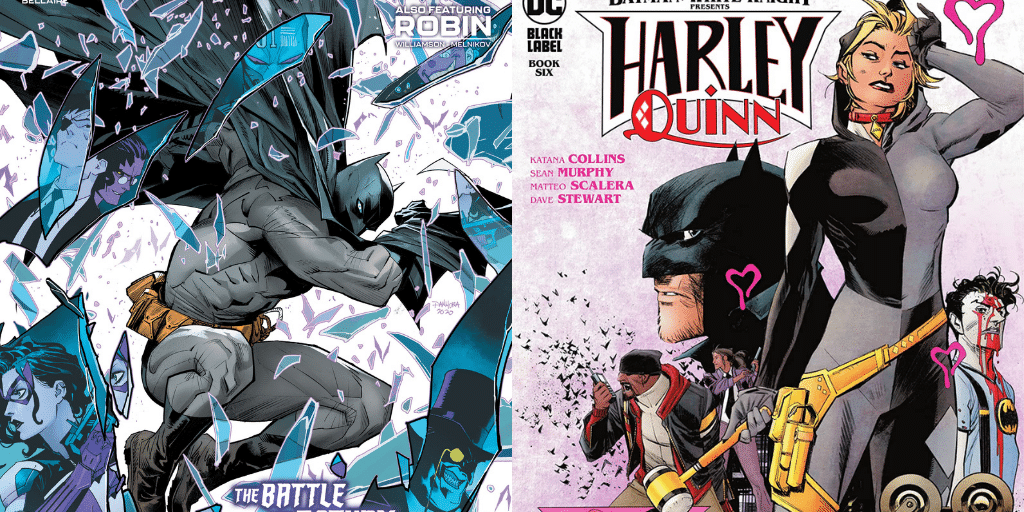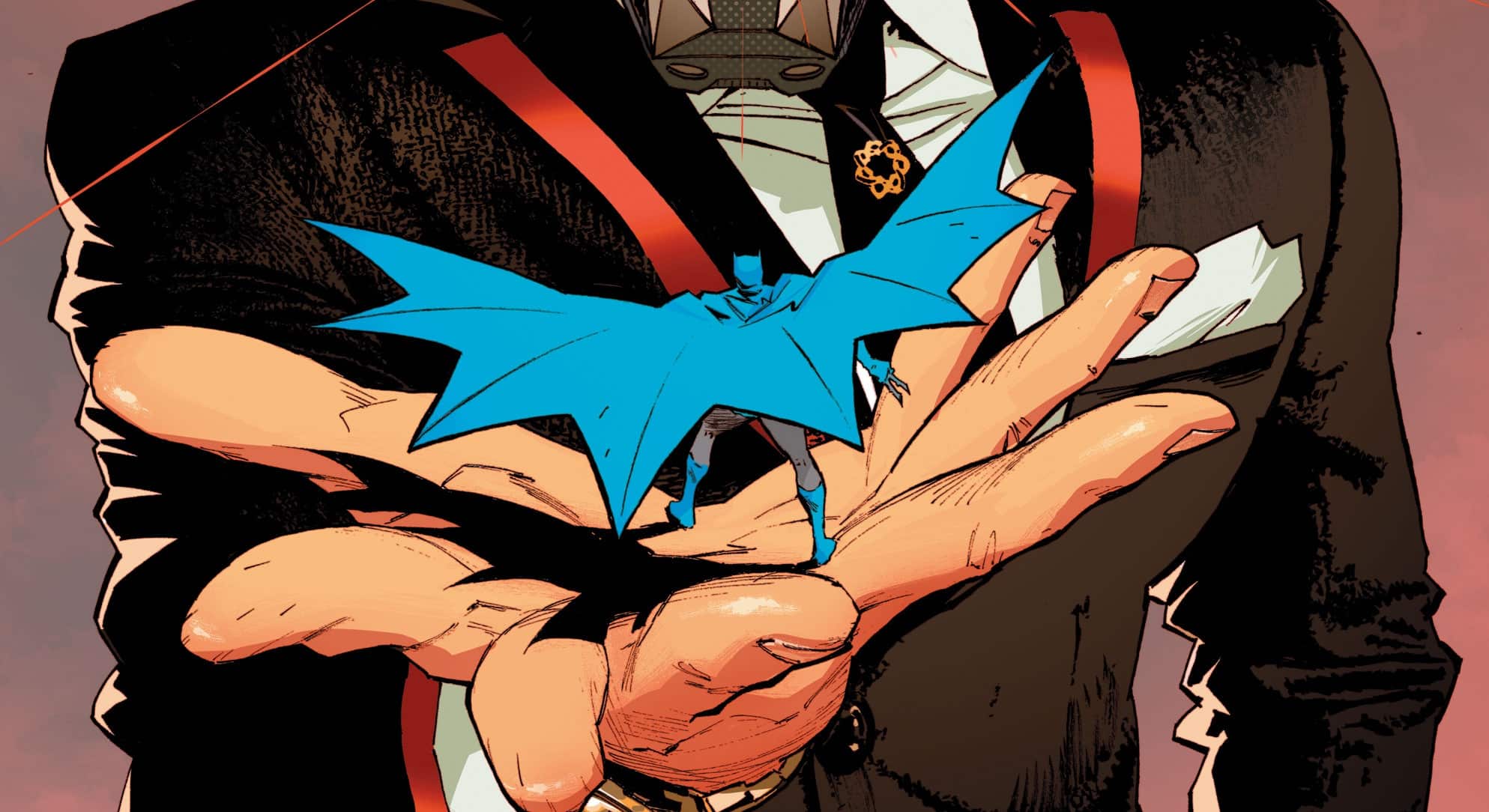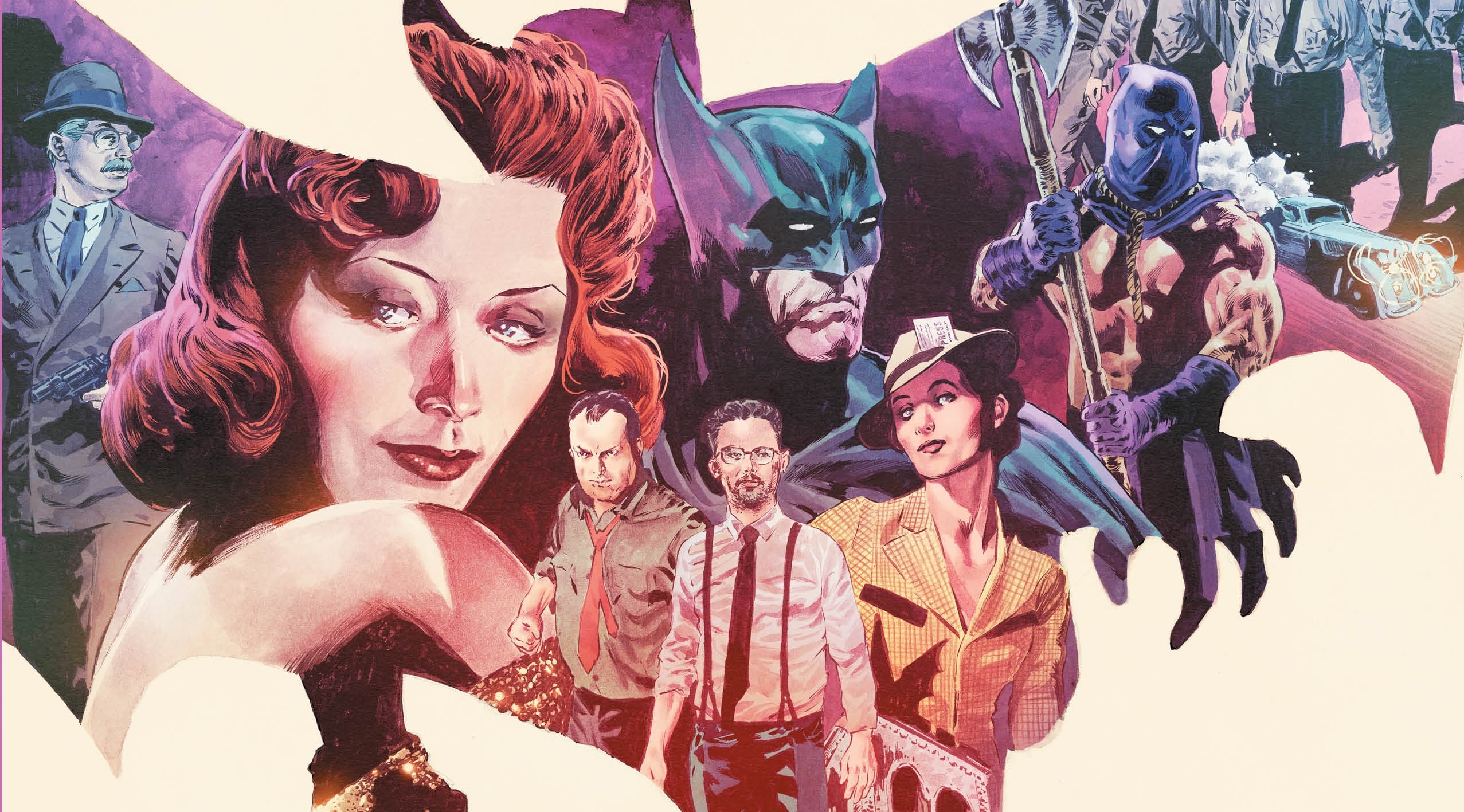Welcome back to Bat Chat with Matt (and Will!). In Detective Comics #1,034, Bruce Wayne meets the neighbors while Batman hunts the remnants of Joker’s gangs, while something more sinister starts beneath the streets of Gotham in a story written by Mariko Tamaki, drawn by Dan Mora, colored by Jordie Bellaire and lettered by Aditya Bidikar.
Meanwhile, over in the Murphyverse, well … this is finally over in Batman: White Knight Presents Harley Quinn #6 from Sean Murphy, Katana Collins, Matteo Scalera, Dave Stewart and AndWorld Design.
Matt Lazorwitz: So this week, we’ve got the highly anticipated new creative team on Detective Comics and the finale of White Knight: Harley Quinn. But they are highly anticipated for very different reasons.
Will Nevin: I agree — this is a time for celebration. ’Tec is new and fresh and different and really clicking in some nice ways. And with Harley Quinn, we crawled through six issues of shit, and we’re now free and clear on the other side. I feel like a new man.
Bruce Wayne Goes to a Party

WN: Here’s my shower thought of the day: The mayor of Gotham — as a character in Batman’s universe — is always an antagonist or flawed in some way. That’s a contrast to Jim Gordon, who exists to be a Good Cop (TM) and is defined in other ways by his relationships with his family members (which is also a measure of being a legacy character more than a transitory figure, like all these mayors seem to be). But, yeah, Gotham’s mayor (whoever he or she is) can’t simply be or perform their functions adequately in the Batman universe — they have to be screwed up in some way. Nakano is prideful, a touch incompetent and physically scarred (I stand by my hypothesis he’s going to break psychotically bad, given the emphasis on his disability, and he sure talks a whole lot about “vision”), so we’ve got a lot to work with as he becomes part of the canon — for however long he’s going to be here.
ML: I won’t be surprised if Nakano breaks bad, and I think that would be his manner of fall if he does, rather than being caught in a corruption scandal like Mayors Hill or Hady. He’s too prideful, as you say, to sell out to the Falcones or some other mob family, but he is absolutely a guy who is going to hand Gotham over to Simon Saint and the Magistrate. Setting him up that way allows you to play with him as an antagonist while slowly playing out his fall into madness, if that is where they want to go.
And now that we’re meeting his staff, the idea that a strong staff can bolster a flailing boss, while not precisely true from recent evidence, doesn’t even come in to play. Even disregarding the final page twist, the two guys we meet don’t fill me with a lot of confidence. Neil has zero filter and a temper (and might be a killer), and Hue Vile, well, if the nominative determinism of Gotham has any say, this nebish is going full on villain. Also, my one quibble with the art here is I wish that character had a different design. The Steve Jobs-esque black turtleneck and tablet made me initially think this was Simon Saint. The two designs feel too similar.
WN: Agreed on all points. Some of it feels like putting a hat on a hat, too — why go with three corrupt underlings when one could serve the same function? And “Hue Vile” is almost as groan-inducing as anything Tynion has cooked up over in Batman as far as character names go. All of that aside, I do like where the story seems to be going: orchestrating attacks on the wealthy to gain their support for what will eventually become the Magistrate. False flag, baybee!
ML: At least he has Montoya as police commissioner, but I would have liked to see her pop up. We’ll see as the series progresses.
Meanwhile, Bruce has some new neighbors, on top of the grouchy old crank we met in Batman #106. I’m not sure if any of these yuppy characters feel like they have much staying power; they’re mostly as one-note as Mr. Potter from that Batman issue, which I’m not going to fault Tamaki for too much. Many a great mystery storyteller has told stories with cardboard suspects and victims; you can’t spend too much time fleshing out people who are just going to be killed off. I initially was thinking that Deb Donovan, the reporter, felt redundant, since Gotham already has Vicki Vale, another red-headed reporter, but it’s harder to have your ex call you to account; a new voice is needed there, and comics do have a history of great tough reporters. The alliteration in her name also makes me think she’ll be around longer, but that’s just genre savviness more than anything in the story.
WN: Donovan also seemed to be a bit older, but maybe that was me reading into it. Also, I’m a sucker for the “hard drinking reporter” trope.
ML: No, I think you’re right. Everyone else there looked to be Dick Grayson’s contemporaries, while she was closer to Bruce’s age.
Batman Goes to the Sewers
ML: It was a nice change that so much of this issue focused on Bruce. It’s been a while since I feel like the Bruce Wayne aspect of the character has really been focused on by any creator. But I could go on about that at length another time.
The Batman parts of this story are playing more into the “Batman has fewer resources” thing, and I feel like this worked a little better than it did in the recent Batman issue. Bruce is actively digging in tunnels by himself, and we see him stretching and having an aching back. With as many Robins as there are, and finally really getting away from the New 52’s idea that everyone is 25, Bruce has to be around 40 at this point, and it’s nice to see someone address what is going on with his body, without going full on Kingdom Come with him being so broken he needs an exo-frame.
WN: I always hated that one of the core conceits of Batman in New 52 is that he’s gone through damn near a half dozen Robins in five years. That never made any sense to me. But yeah, to your point, it’s good to see Bruce displaying some physical vulnerability. Batman is best when he’s human, when he’s tested. We want to see him win, of course — but he should have to put in some effort.
ML: He needs to use his brain, not just the toys. That’s the thing that appeals to me. A Batman who carries a Bat-anti-clown-villain-array only works in very limited situations: when he’s a camp gag or when he’s playing the straight man in a highly stylized world. And those aren’t the Batmans I want to see in my ongoing Batbooks.
And how much longer do you think we can see remnants of “Joker War” before it gets to be too much? I do like the fact that we’re seeing a story resonate after it’s over and not just be cleaned up, and we’re getting different clown-inspired gangs at least, but I can’t see this going on for much longer without it getting old. Although it would be fun to see the guys who hung onto their Wayne Tech gadgets eventually be better armed than Batman. That would be a challenge.
WN: The “Joker War” epilogue as a plot point is definitely starting to drag, but that seems like a function of this new run being preempted by Future State — if we could have rolled smoothly from “Joker War” without having that interruption, maybe there wouldn’t be the need to keep hitting the point that Gotham is new and different. It could also be fatigue on our part as readers since this seems to be a note in all of the books from Batman to Joker.
Batman: White Knight Presents Harley Quinn #6

WN: It’s over, Brother Matt. Blessedly over. And the best I can say is that it’s finished, and I didn’t groan too many times during this final issue. All of the problems of the Murphyverse are as visible as they’ve ever been in #6 — too much dialogue, plot points that don’t make any sense, the stench of badly written fanfic — but I maybe disliked this issue the least. (Try parsing that double negative, why dontcha?) It’s over (until the third volume of the main story), and that makes me happy.
ML: Yeah, Murphy and Co. don’t avoid any of their cardinal sins, but they don’t roll around in them either. I’m not in love with Harley’s black and white costume, just because it doesn’t really fit the character, but if that’s my biggest complaint? I suppose it could be much worse.
WN: Putting Harley into what amounts to be a Batsuit spoke to me about his desires to erase the qualities of the character he doesn’t like: His idealized Harley isn’t sexy or queer, and now, she’s not even Harley; she’s only a tool or an extension of other characters like Batman or Joker. No agency or independence. If I was Paul Dini or Bruce Timm, I’d throw a brick through his window.
ML: Now that we’ve reached the end, as the resident expert on the Murphyverse, can you rank the three series that have appeared thus far for our readers?
WN: Oh, Jesus. That’s like ranking all the times I had stomach flu or had to diagram sentences. Far and away, the worst chapter is the second volume, Curse of the White Knight, because it’s so interminably boring — Murphy goes into all of this ancient Gotham history and spends so much time fucking around with it and it just drags. That volume also has the indignity of the Mr. Freeze one-shot where he tries to be Super Smart and work in his big, deep thoughts about the Holocaust. So yeah, Curse blows the fuckin’ hardest. Then, I guess it’s the original book; it stinks because of an insipid third act and Murphy’s Super Smart ideas about class and social justice. By process of elimination, Presents Harley Quinn: A SGM and His Partner Production has to be the winner. My unsolicited blurb: “Of all of the Batman stories Sean Gordon Murphy has had a hand in producing, this one sucks the least. But it still sucks!” Somehow, I don’t think that’s making the back of the book.
Bat-miscellany
- Batman: Black and White #3 — abiding by the Universal Rule of Anthologies — has some good and some bad. Karl Kerschl’s “Davenport House” starts slow but builds to a really neat concept with a great twist. Big Daddy Chip Z’s “The Green Deal” unfortunately has some fundamental miscalculations: If you’re going to tell a Poison Ivy story, it probably shouldn’t be in black and white, and Ivy exhuming the Waynes to get Bruce’s attention seems way out of character and gross AF.
- The Robin in the Kerschl story is an Easter egg from his Gotham Academy series. She’s Mia “Maps” Mizoguchi, a big Batman and Robin fangirl who was one of the principal characters of that series, and a friend of Damian’s during his brief time at the school. It’s fun to see Maps again, even if she doesn’t get to do a ton.
- I also enjoyed “A Day in the Life of a Bat in Gotham,” but that was very much for the art. The story was OK, but you put Riley Rossmo on anything, and I’ll enjoy it. And Jen Bartel’s Cassandra Cain pin-up really drew my attention. Love to see Bartel do a Cass story.
- We didn’t talk about the “Robin” back-up in Detective, since it is the second half of the story from Batman and not much is different, but my ’90s DC fanboy heart sang in delight at the character reveal on the last page. I won’t spoil it, but if you are a fan of that era of DC Comics, a long absent character has returned and I couldn’t be happier, even if it seems he’s in a pretty bad way.







